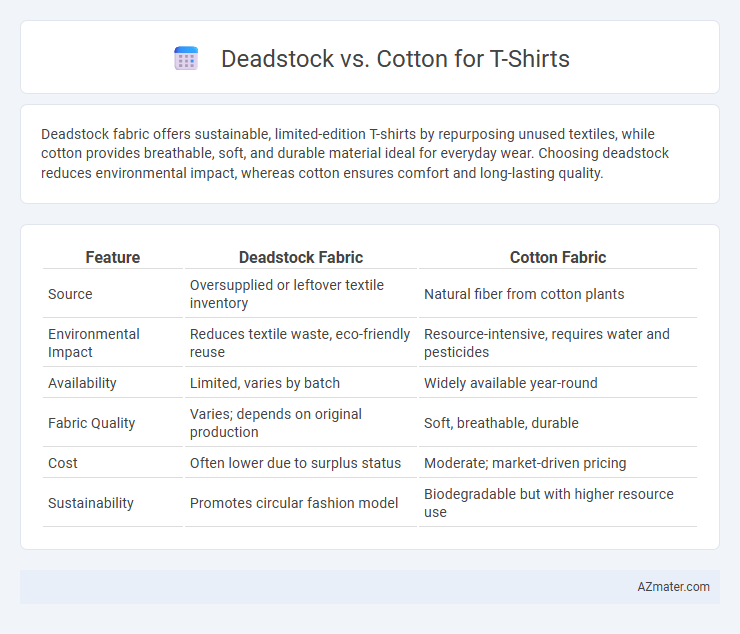Deadstock fabric offers sustainable, limited-edition T-shirts by repurposing unused textiles, while cotton provides breathable, soft, and durable material ideal for everyday wear. Choosing deadstock reduces environmental impact, whereas cotton ensures comfort and long-lasting quality.
Table of Comparison
| Feature | Deadstock Fabric | Cotton Fabric |
|---|---|---|
| Source | Oversupplied or leftover textile inventory | Natural fiber from cotton plants |
| Environmental Impact | Reduces textile waste, eco-friendly reuse | Resource-intensive, requires water and pesticides |
| Availability | Limited, varies by batch | Widely available year-round |
| Fabric Quality | Varies; depends on original production | Soft, breathable, durable |
| Cost | Often lower due to surplus status | Moderate; market-driven pricing |
| Sustainability | Promotes circular fashion model | Biodegradable but with higher resource use |
Understanding Deadstock Fabric for T-Shirts
Deadstock fabric consists of unused, surplus textiles from previous production runs that remain unsold or unutilized. This material offers unique qualities such as vintage textures and patterns, making it a sustainable choice by minimizing waste in T-shirt manufacturing. Compared to cotton, deadstock fabric reduces environmental impact by repurposing existing resources without the need for new cultivation or processing.
What Is Cotton and Why Is It Popular for Tees?
Cotton is a natural fiber derived from the cotton plant, known for its softness, breathability, and moisture-wicking properties, making it ideal for T-shirts. Its popularity stems from its hypoallergenic qualities, durability, and ease of dyeing, which results in vibrant, long-lasting colors. Cotton fabrics also offer comfort in various climates, contributing to their widespread use in casual and fashion apparel.
Sustainability: Deadstock vs Cotton
Deadstock fabric repurposes surplus materials, significantly reducing textile waste and minimizing environmental impact compared to conventional cotton production, which demands extensive water, pesticides, and land resources. Cotton cultivation often contributes to soil degradation and high carbon emissions, whereas deadstock utilizes existing textiles, aligning with circular fashion principles and promoting resource efficiency. Choosing deadstock over cotton supports sustainable manufacturing by lowering waste and conserving natural resources essential for eco-friendly T-shirt production.
Quality and Durability Compared
Deadstock fabrics often consist of vintage or limited-run materials prized for unique textures and high-quality craftsmanship, resulting in T-shirts with exceptional durability and distinctive wear patterns over time. Cotton, especially premium varieties like Pima or Egyptian, offers natural breathability and softness while maintaining strong fiber integrity for long-lasting comfort and resilience. Comparing both, deadstock T-shirts emphasize rarity and character with robust fabric heritage, whereas cotton T-shirts provide consistent durability paired with everyday comfort benefits.
Comfort and Wearability Differences
Deadstock cotton often offers a more vintage, broken-in feel, enhancing comfort through its softer texture and lower processing levels compared to regular cotton. Cotton used in new production typically provides a consistent, smooth surface with greater breathability and moisture absorption, ideal for wearability in active or hot environments. Over time, deadstock cotton naturally adapts to body contours and movements, resulting in unique comfort and durability advantages not always present in standard cotton T-shirts.
Cost Considerations: Deadstock vs Cotton
Deadstock fabric often reduces costs by utilizing surplus or unused textile inventories, lowering material expenses compared to purchasing new cotton. Cotton, particularly organic or high-quality varieties, tends to have higher procurement costs due to farming, processing, and sustainability certifications. Choosing deadstock over cotton can significantly impact overall production budgets, especially in small-scale or eco-conscious apparel manufacturing.
Environmental Impact Assessment
Deadstock fabric, sourced from surplus or unsold textiles, significantly reduces waste by repurposing existing materials, minimizing landfill contributions and the carbon footprint associated with producing new fabric. Cotton cultivation requires extensive water, pesticide use, and land resources, often leading to soil degradation and high greenhouse gas emissions throughout its lifecycle. Choosing deadstock over conventional cotton for T-shirts supports circular fashion practices, lowering environmental impact by avoiding further resource-intensive agricultural processes.
Style and Aesthetic Choices
Deadstock fabric offers unique, vintage-inspired textures and patterns that enhance the style of T-shirts with an exclusive, retro aesthetic. Cotton provides versatility with a wide range of finishes, enabling classic, minimalist, or modern looks tailored to diverse fashion trends. Choosing deadstock elevates T-shirts into statement pieces, while cotton ensures comfort and timeless appeal in everyday wear.
Sourcing and Availability of Materials
Deadstock materials refer to unused or leftover fabric from previous production runs, offering limited availability that often varies by supplier and season. Cotton, particularly organic or sustainably sourced varieties, is widely available through established agricultural and textile supply chains, ensuring consistent access for T-shirt manufacturing. Sourcing deadstock supports eco-friendly practices by reducing waste but requires flexible production schedules due to its unpredictable inventory, whereas cotton provides reliable volume and quality control for large-scale operations.
Which Is Better for T-Shirts: Deadstock or Cotton?
Deadstock T-shirts offer unique, limited-edition fabrics that emphasize sustainability by repurposing unused inventory, while traditional cotton T-shirts provide unmatched softness, breathability, and durability due to natural fiber properties. Organic cotton variants enhance eco-friendliness through chemical-free cultivation, appealing to environmentally conscious consumers. The choice depends on prioritizing exclusivity and sustainability in deadstock versus the proven comfort and versatility of high-quality cotton.

Infographic: Deadstock vs Cotton for T-shirt
 azmater.com
azmater.com